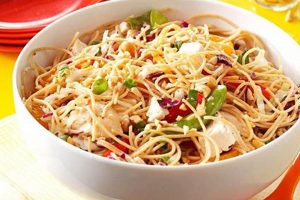A combination of cooked chicken, mayonnaise, and diced apples creates a refreshing and flavorful dish. Often, celery, onion, and grapes are incorporated, alongside seasonings like salt, pepper, and herbs. Variations can include nuts, dried cranberries, or curry powder. A simple version might involve shredded chicken, mayonnaise, diced apple, and celery, while more complex versions can feature a variety of ingredients and dressings.
This blend of savory and sweet flavors offers a versatile dish suitable for sandwiches, salads, wraps, or as a standalone appetizer. The addition of apples provides textural contrast and a nutritional boost. Historically, such combinations arose from the need to utilize readily available ingredients in creative ways, transforming simple components into satisfying meals. The balance of protein, healthy fats, and natural sweetness makes it a popular choice for light lunches or picnics.
Further exploration could delve into specific ingredient combinations, preparation techniques, nutritional information, and variations suitable for different dietary needs. One might also investigate the historical evolution of such dishes and their place in various culinary traditions.
Tips for Creating a Delicious Apple Chicken Salad
This section offers guidance on enhancing the flavor and texture of this classic dish.
Tip 1: Chicken Selection: Using pre-cooked rotisserie chicken offers convenience. Poaching or grilling chicken breasts provides a leaner option, ensuring a clean, mild flavor that complements the other ingredients.
Tip 2: Apple Choices: Crisp, tart apples such as Granny Smith, Honeycrisp, or Fuji provide a pleasant contrast to the richness of the mayonnaise. Softer varieties may become mushy.
Tip 3: Mayonnaise Considerations: Full-fat mayonnaise creates a creamier texture, while Greek yogurt or light mayonnaise offer lower-fat alternatives. A combination of both can balance flavor and calorie content.
Tip 4: Enhancing Flavor Profiles: Incorporating ingredients like grapes, dried cranberries, walnuts, or pecans adds sweetness and textural complexity. Fresh herbs such as tarragon, dill, or chives contribute a bright, aromatic element.
Tip 5: Seasoning Recommendations: Salt and freshly ground black pepper are essential. Consider adding a pinch of celery seed, onion powder, or a dash of paprika for depth of flavor.
Tip 6: Balancing Sweetness and Tartness: A squeeze of lemon juice brightens the flavors and prevents the apples from browning. A touch of honey or maple syrup can be added for extra sweetness if desired.
Tip 7: Chilling and Serving: Chilling the salad for at least 30 minutes allows the flavors to meld. Serve on bread, crackers, lettuce wraps, or as a filling for croissants.
By following these suggestions, one can create a balanced and flavorful dish. Attention to detail regarding ingredient selection, preparation techniques, and flavor combinations yields optimal results.
By understanding these elements, one can confidently create a customized and delicious apple chicken salad.
1. Chicken (cooked, diced)
Cooked, diced chicken forms the foundational protein component of this salad. Its preparation method significantly influences the final dish’s overall flavor and texture. Overcooked chicken results in a dry, stringy salad, while undercooked chicken presents food safety risks. Properly cooked chicken, whether roasted, poached, or grilled, provides a tender, flavorful base. Dicing the chicken into uniform pieces ensures even distribution throughout the salad and facilitates consistent flavor in each bite. For instance, using roasted chicken imbues the salad with subtle smoky notes, while poached chicken offers a cleaner, more neutral flavor profile. This foundational element sets the stage for the interplay of other ingredients.
The size of the diced chicken also plays a critical role. Larger pieces provide a more substantial bite, while smaller pieces create a smoother, more cohesive texture. The choice depends on personal preference and the desired final product. Consider the other ingredients when determining the appropriate size; larger chicken pieces pair well with similarly sized apple and celery chunks, while smaller pieces blend seamlessly with finely chopped ingredients like grapes or nuts. This attention to detail elevates the dish beyond a simple mixture of ingredients to a carefully constructed culinary creation.
Understanding the significance of properly cooked, diced chicken ensures a successful and enjoyable apple chicken salad. It provides not only nutritional value but also contributes significantly to the texture and overall eating experience. Attention to this seemingly basic ingredient sets the foundation for a well-balanced and flavorful dish, highlighting the crucial interplay between technique and ingredients.
2. Apples (crisp, diced)
Apples, specifically crisp and diced varieties, contribute significantly to a successful chicken salad. Their inclusion introduces a crucial textural and flavor dimension, enhancing the overall culinary experience. The crispness offers a refreshing counterpoint to the softer textures of chicken and mayonnaise, while the sweetness provides a balancing contrast to the savory elements. This interplay of textures and flavors elevates the dish beyond a simple protein-based salad, adding complexity and interest. For example, a Granny Smith apple, with its tartness and firm texture, provides a vibrant contrast to the richness of the mayonnaise, while a Honeycrisp apple offers a sweeter, slightly milder complement. The choice of apple variety directly influences the salad’s overall flavor profile.
Dicing the apples into consistent, bite-sized pieces ensures even distribution throughout the salad. This uniformity promotes balanced flavor and texture in each bite, preventing pockets of overwhelming sweetness or large, unwieldy chunks. Furthermore, smaller pieces absorb flavors from the dressing and other ingredients more readily, creating a more cohesive and flavorful experience. The size of the dice can also be adjusted to match other ingredients, such as celery or grapes, ensuring a harmonious blend of textures and flavors. Overly large apple pieces can disrupt the balance, overpowering other components, while overly small pieces may become lost within the mixture. Proper dicing technique, therefore, optimizes the apple’s contribution to the salad’s overall composition.
The selection and preparation of apples demonstrate a critical understanding of their role in a chicken salad. Balancing sweetness, texture, and size contributes significantly to the final product’s appeal. Apples, when thoughtfully incorporated, transform a basic chicken salad into a more complex and satisfying dish, showcasing the synergy achievable through careful ingredient selection and preparation.
3. Mayonnaise (or alternative)
Mayonnaise serves as the binding agent in chicken salad, contributing significantly to its texture, flavor, and overall palatability. The choice of mayonnaise, or an alternative, directly impacts the salad’s richness, creaminess, and caloric content. Understanding the role of this ingredient is crucial for creating a well-balanced and enjoyable dish. Careful consideration of available options allows for customization based on dietary preferences and desired flavor profiles.
- Traditional Mayonnaise
Traditional mayonnaise, an emulsion of oil, egg yolks, and vinegar or lemon juice, provides a rich, creamy texture and tangy flavor. Its high fat content contributes to the salad’s luxurious mouthfeel and helps to bind the ingredients together effectively. However, this richness also adds significant calories. A classic chicken salad often relies on traditional mayonnaise for its familiar flavor and binding properties. The choice of a specific brand can further influence the flavor profile, as some may incorporate additional ingredients like herbs or spices.
- Light Mayonnaise
Light mayonnaise offers a lower-fat and calorie alternative to traditional mayonnaise. While it may sacrifice some creaminess and richness, it provides a lighter texture and reduces the overall caloric impact. This option caters to those seeking a healthier version of chicken salad without drastically altering the flavor profile. Using light mayonnaise can result in a slightly less cohesive texture, so incorporating a small amount of Greek yogurt can help improve binding and add a tangy note.
- Greek Yogurt
Greek yogurt, a high-protein dairy product, presents a tangier and significantly healthier alternative to mayonnaise. Its lower fat content and higher protein content make it a nutritious option for health-conscious individuals. Greek yogurt adds a distinct tanginess that complements the sweetness of the apples and the savory chicken, while its thick consistency effectively binds the salad ingredients. A combination of Greek yogurt and a small amount of mayonnaise can achieve a balance between health benefits and desired creaminess.
- Avocado-Based Mayonnaise
Avocado-based mayonnaise, utilizing avocado as the primary emulsifier, offers a vegan and allergen-friendly option. It provides a creamy texture and a subtle, nutty flavor that complements the other ingredients in the salad. This option caters to specific dietary needs while still delivering a rich and flavorful experience. Avocado mayonnaise tends to have a milder flavor compared to traditional mayonnaise, allowing the flavors of the chicken and apple to shine through. Its vibrant green hue can also add a visually appealing element to the salad.
The selection of mayonnaise or an alternative significantly impacts the overall flavor, texture, and nutritional value of the chicken salad. Choosing the right option involves considering individual dietary preferences and desired characteristics. Whether prioritizing richness, health benefits, or specific dietary restrictions, the chosen binding agent plays a key role in the final product’s success. Each option offers a unique set of characteristics, allowing for customization and creation of a truly personalized chicken salad experience.
4. Seasoning (salt, pepper)
Seasoning, primarily salt and pepper, plays a crucial role in the flavor profile of chicken salad with apples. Salt enhances the inherent flavors of the chicken and apples, while pepper adds a subtle layer of complexity and spice. The careful balance of these two seasonings elevates the dish from bland to vibrant. Insufficient seasoning results in a flat, unappealing taste, while excessive seasoning overwhelms the delicate flavors of the other ingredients. For example, a pinch of sea salt amplifies the sweetness of the apples and the savory notes of the chicken, while freshly ground black pepper provides a subtle warmth and bite. The interaction between these seasonings and the other ingredients creates a harmonious and well-rounded flavor profile.
Beyond basic salt and pepper, other seasonings can further enhance the chicken salad’s flavor profile, depending on the desired outcome. A dash of onion powder adds a subtle savory depth, while a pinch of garlic powder contributes a pungent note. Herbs such as dill, tarragon, or chives introduce bright, fresh flavors that complement the apples. The judicious use of these additional seasonings adds layers of complexity without overpowering the core flavors of the chicken, apples, and mayonnaise. However, care must be taken to avoid over-seasoning, as too many competing flavors can create a muddled and unbalanced taste. A balanced approach allows each ingredient to contribute to the overall flavor profile without dominating the others.
The proper application of seasoning is fundamental to achieving a balanced and flavorful chicken salad with apples. Salt and pepper provide the foundation, enhancing the natural flavors of the core ingredients. The considered addition of other seasonings further elevates the dish, creating a complex and nuanced flavor profile. Understanding the impact of each seasoning allows for precise control over the final taste, transforming a simple combination of ingredients into a culinary delight. The careful balancing act between enhancing and overpowering flavors underscores the importance of thoughtful seasoning in achieving culinary excellence.
5. Optional additions (celery, grapes)
Optional additions, such as celery and grapes, offer opportunities to enhance both the flavor and textural complexity of chicken salad with apples. These additions, while not essential to the core recipe, provide nuanced dimensions that elevate the dish beyond its basic components. Careful consideration of these additions allows for customization and a more sophisticated culinary experience.
- Celery
Celery contributes a crisp, slightly vegetal flavor and a satisfying crunch. Its subtle bitterness provides a counterpoint to the sweetness of the apples and the richness of the mayonnaise. Finely diced celery distributes evenly throughout the salad, ensuring a balanced flavor in each bite. The added moisture from celery can also help balance a salad that might otherwise be too dry, particularly if using lean chicken breast. Moreover, celery’s pale green color adds visual appeal to the final presentation.
- Grapes
Grapes introduce a burst of sweetness and a juicy texture that complements the other ingredients. Red or green seedless grapes offer a convenient and readily available option. Halved or quartered grapes provide optimal size for incorporation into the salad, preventing them from becoming overly dominant in texture or flavor. The natural sweetness of grapes enhances the overall flavor profile, while their juicy texture adds a refreshing element. The color of the grapes also contributes visual interest.
- Nuts
Nuts, such as walnuts, pecans, or almonds, provide a rich, earthy flavor and a satisfying crunch. Toasted nuts intensify their flavor and enhance their textural contribution. Chopped nuts distribute well throughout the salad, adding a layer of complexity to each bite. Nuts also contribute healthy fats and protein, increasing the salad’s nutritional value. Their inclusion adds a textural dimension distinct from the crispness of celery and the juiciness of grapes.
- Dried Cranberries
Dried cranberries offer a chewy texture and a concentrated sweetness that complements the tartness of the apples. Their vibrant red color adds a visually appealing element to the salad. The intense sweetness of dried cranberries provides a concentrated flavor burst that contrasts with the savory elements of the chicken and the subtle bitterness of the celery. The chewy texture adds another layer of complexity, distinct from the crisp and juicy elements of other additions.
The inclusion of optional additions like celery, grapes, nuts, and dried cranberries elevates the chicken salad with apples from a simple dish to a more complex and nuanced culinary creation. These additions contribute not only to flavor and texture but also to visual appeal and nutritional value. The careful selection and incorporation of these optional ingredients demonstrate an understanding of their individual contributions and their synergistic effects within the overall composition of the salad.
6. Texture (balance, contrast)
Textural balance and contrast contribute significantly to the enjoyment of chicken salad with apples. A successful recipe considers the interplay of textures, creating a harmonious and engaging sensory experience. This exploration delves into the various textural elements present in this dish and their combined effect on overall palatability.
- Chicken
Cooked chicken, typically diced or shredded, provides a tender, slightly fibrous texture. The cooking method influences the final texture; poached chicken offers a softer, more delicate texture, while roasted or grilled chicken presents a slightly firmer, more substantial feel. The size of the chicken pieces also affects the overall texture, with smaller pieces creating a smoother, more uniform experience and larger pieces offering more pronounced chewiness.
- Apples
Apples introduce a contrasting crispness and juiciness. The variety of apple influences the specific textural experience; a firm, tart apple like Granny Smith offers a pronounced crunch, while a sweeter apple like Honeycrisp provides a slightly softer, more yielding bite. The size of the apple pieces also impacts the overall texture. Larger pieces offer a more assertive crunch, while smaller pieces integrate more seamlessly with other ingredients, creating a more uniform texture.
- Mayonnaise (or alternative)
Mayonnaise, or a chosen alternative, contributes a creamy, smooth texture that binds the ingredients together. Traditional mayonnaise offers a rich, luxurious mouthfeel, while lighter alternatives or Greek yogurt provide a less dense, tangier element. The choice of binding agent directly influences the overall textural profile, impacting the balance between creamy and other textural components.
- Optional Additions
Optional additions such as celery, grapes, nuts, or dried cranberries introduce further textural complexity. Celery offers a crisp, watery crunch, grapes provide a juicy burst, nuts contribute a firm chewiness, and dried cranberries offer a slightly chewy, concentrated texture. These additions create layers of textural contrast, enhancing the overall sensory experience and preventing a monotonous texture.
The interplay of these various texturestender chicken, crisp apples, creamy mayonnaise, and potentially crunchy or chewy additionscreates a dynamic and satisfying culinary experience. A well-balanced chicken salad avoids textural monotony, offering a combination of smooth, crisp, and potentially chewy elements. The careful consideration of texture in ingredient selection and preparation elevates the dish from a simple combination of flavors to a multi-faceted sensory delight, demonstrating the importance of textural balance and contrast in culinary artistry.
7. Flavor (sweet and savory)
The interplay of sweet and savory flavors forms a defining characteristic of chicken salad with apples. This dynamic balance distinguishes the dish, offering a complex flavor profile that appeals to a broad range of palates. The sweetness derives primarily from the apples, with their inherent sugars providing a refreshing counterpoint to the savory elements. The specific apple variety influences the intensity of sweetness; a Honeycrisp offers a pronounced sweetness, while a Granny Smith provides a more tart, less sugary note. This sweetness interacts with the savory notes of the chicken, creating a balanced flavor profile. The savory aspect originates from the chicken itself, enhanced by the addition of mayonnaise or alternatives. Mayonnaise contributes a tangy, rich flavor, while Greek yogurt offers a more tart, less fatty profile. Additional savory notes can be introduced through seasonings like salt, pepper, onion powder, or garlic powder. The interplay of these sweet and savory elements creates a harmonious and balanced flavor profile.
This balance is crucial to the overall success of the dish. An overly sweet salad can become cloying, while an overly savory salad can lack complexity and freshness. The careful balancing of sweet and savory elements ensures that neither flavor profile dominates, creating a nuanced and satisfying taste experience. For instance, the sweetness of the apples tempers the richness of the mayonnaise, while the savory notes of the chicken prevent the salad from becoming overly sweet. This delicate balance allows the individual flavors to shine while contributing to a cohesive whole. Furthermore, optional additions such as grapes, dried cranberries, or nuts can further influence the sweet-savory balance, adding layers of complexity to the flavor profile. Grapes enhance the sweetness, while nuts contribute savory, earthy notes.
Understanding the interplay of sweet and savory flavors in chicken salad with apples allows for precise control over the final taste. Careful ingredient selection, including specific apple varieties and mayonnaise alternatives, allows for tailoring the flavor profile to individual preferences. The judicious use of seasonings and optional additions further refines the balance, creating a customized culinary experience. This understanding transforms a simple recipe into an opportunity for culinary expression, demonstrating the profound impact of flavor balance on the overall enjoyment of a dish.
Frequently Asked Questions
This section addresses common inquiries regarding the preparation and enjoyment of chicken salad incorporating apples.
Question 1: What type of apple is best suited for chicken salad?
Crisp, tart apples such as Granny Smith, Honeycrisp, or Fuji maintain their texture and provide a refreshing contrast to the richer elements. Softer apples may become mushy.
Question 2: How can one prevent the apples from browning in the salad?
A light coating of lemon juice inhibits enzymatic browning. Incorporating the apples into the salad immediately after dicing also minimizes exposure to air.
Question 3: What are suitable alternatives to mayonnaise?
Greek yogurt provides a lighter, tangier alternative. Avocado-based mayonnaise offers a vegan option. A combination of mayonnaise and Greek yogurt can balance flavor and texture.
Question 4: How long can chicken salad with apples be stored?
Properly stored in an airtight container in the refrigerator, it typically remains safe to consume for up to three to five days. Monitor for any signs of spoilage.
Question 5: Can canned chicken be used in this recipe?
While canned chicken offers convenience, it often possesses a softer texture. Draining the liquid thoroughly is essential to prevent a watery salad. Rotisserie or freshly cooked chicken generally yields superior results.
Question 6: How can one elevate the flavor profile of the salad?
Fresh herbs such as tarragon, dill, or chives add brightness. Incorporating nuts, dried cranberries, or grapes introduces textural and flavor complexity. Seasonings like curry powder or celery seed offer additional depth.
Understanding these common points of inquiry aids in the creation of a satisfying and flavorful apple chicken salad. Careful consideration of ingredient selection, preparation techniques, and storage practices contributes to an enjoyable culinary experience.
For further exploration, one might delve into specific recipe variations and nutritional information.
Chicken Salad Recipe with Apples
Exploration of this dish reveals the importance of balancing key components. Properly cooked chicken provides a foundational protein base, while crisp apples introduce contrasting sweetness and texture. Mayonnaise, or a selected alternative, binds these elements, contributing richness and creaminess. Careful seasoning enhances inherent flavors, while optional additions such as celery, grapes, or nuts further elevate the dish’s complexity. Textural contrast, achieved through a combination of tender chicken, crisp apples, and creamy mayonnaise, enhances the sensory experience. The delicate balance between sweet and savory notes defines the characteristic flavor profile.
Culinary success hinges on a thorough understanding of these fundamental elements. Consideration of individual ingredients, their preparation, and their interaction contributes to a nuanced and satisfying result. This knowledge empowers culinary exploration and personalized variations, demonstrating the enduring appeal of this versatile and adaptable dish.






